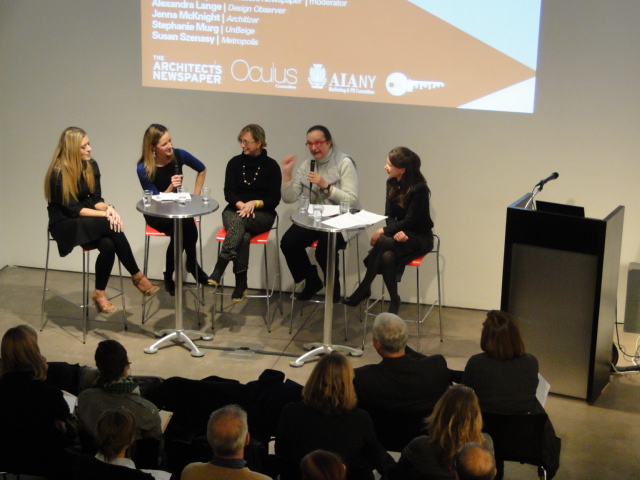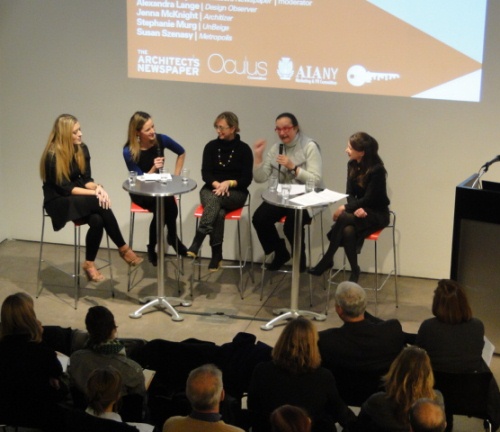by: Murrye Bernard Assoc. AIA LEED AP
Event: Evolving Media Platforms (Architecture and the Media #4)
Location: Center for Architecture, 11.08.12
Moderator: Molly Heintz, The Architect’s Newspaper
Panelists: Alexandra Lange, Design Observer; Jenna McKnight, Architizer; Susan Szenasy, Hon. AIANY, Editor, Metropolis; and Stephanie Murg, UnBeige
Organizer: Center for Architecture and the AIANY Oculus Committee and Marketing & PR Committee; co-organized by The Architect’s Newspaper
For the fourth and final event in the “Architecture and the Media” series, a panel of editors and writers discussed the shift in architectural publications from print to primarily digital content. They weighed in on how writing for the web differs from print, the benefits and drawbacks of disseminating information through digital platforms, and offered fresh advice for architects looking to get their work published online.
Only two publications represented, Metropolis and The Architect’s Newspaper, have print components, which are supplemented by an online presence; the others – Design Observer, Architizer, and UnBeige – are fully digital. Every media outlet is constantly experimenting with new platforms. Alexandra Lange, a regular contributor to Design Observer and self-proclaimed “prolific tweeter,” maintains a blog on Tumblr, and recently published her first eBook. Writing for varied media has allowed her to develop her own voice as a critic while connecting with her audience.
Building connections, particularly between architects and potential clients, is the primary purpose of Architizer. Editor-in-Chief Jenna McKnight, formerly news director at Architectural Record, notes that architecture is often an insular profession that becoming part of a larger community online helps to counteract. Another website that connects architecture with other facets of design is UnBeige, which primarily highlights cultural and institutional projects and draws an international audience.
While many designers are loyal to print, online publishing allows editors to break news quickly and connect with their readers. Panelists agreed, though, that their posts have been receiving less reader comments lately. The reason? They suspect readers are instead sharing links through Twitter or “liking” content on Facebook. Either way, articles published online have the potential to go viral. The ability to link to content also allows editors and writers to use their words more efficiently, explained Stephanie Murg, an editor of Unbeige, by directing readers to other sources to learn basic background on a topic. Susan Szenasy of Metropolis cautioned that too much cross-referencing can be dangerous, and pointed out that we often retain little of the information we scan while surfing the Internet.
The shift towards digital media affects how architects get their work published, and the editors offered some inside advice on how best to reach out to them. They suggest that architects first read through a site and familiarize themselves with the mission of a publication to avoid sending irrelevant information, or worse yet, pitching an idea for a story they’ve already published. Murg suggested that designers keep their project descriptions concise and include a fact sheet. And don’t forget to attach images, which are “like catnip,” according to Molly Heinz of The Architect’s Newspaper. McKnight agreed: “Architecture [in the media] is as much about photography as it is about the building.” The panelists’ best advice for architects? Hire a good photographer.
Murrye Bernard, Assoc. AIA, LEED AP, is a freelance architecture writer and a contributing editor to Contract Magazine and e-Oculus. www.murrye.com










